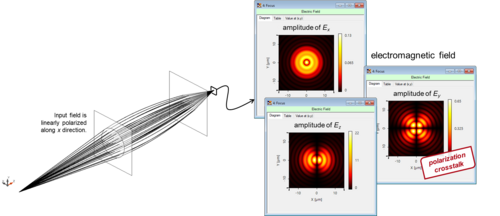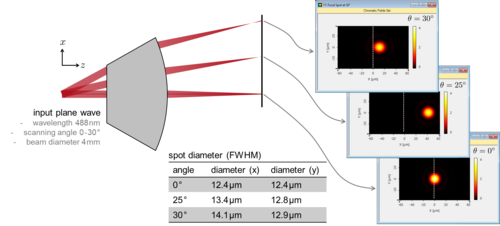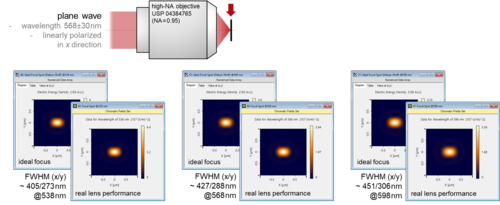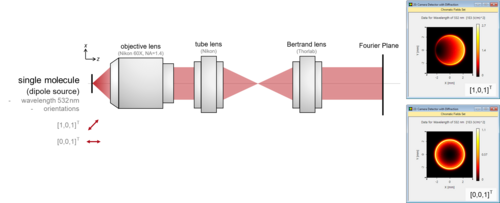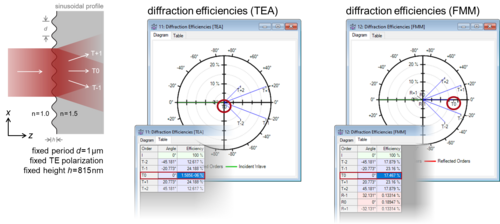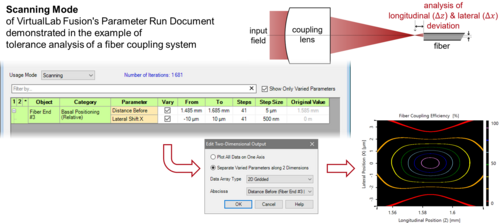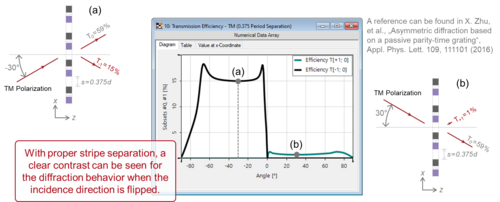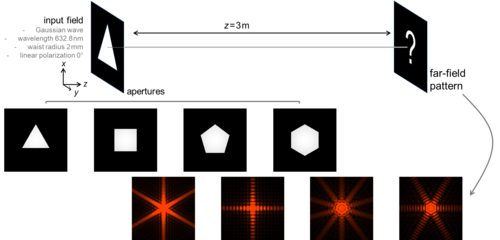What’s new in our Optical Modeling and Design Software?
Construction and Modeling of a GRIN Lens
In contrast to a traditional optical lens, which works due to light refracting at the curved surfaces of the lens, a GRIN lens can make light focus using only flat surfaces. The flat shape and the working principle of such lenses provide advantages – convenience in mounting and even the possibility of being fused to other devices, like an optical fiber. VirtualLab Fusion provides a fully electromagnetic modeling technology for light propagation in GRIN media. We show here an example of a GRIN lens.
Read moreF-Theta Scanning Lens
F-Theta lenses are often employed in high-performance laser scanning systems. They are designed to produce focal spots whose lateral displacement depends linearly on the scanning angle, a property which is typically required in e.g. laser material processing applications. In VirtualLab Fusion, we provide a scanning source for such scenarios, and with different field solvers used in connection, the performance of such scanning lens systems can be evaluated conveniently.
Read moreChromatic Effects in Fluorescent Microscopy
Fluorescent microscopy has proven to be a very effective technology for both biological and medical applications. When constructed in a reflective configuration, both the illuminating light and the light emitted by the fluorescent sample, which have different wavelengths, pass through the same objective lens of the fluorescent microscope. We take such an example and demonstrate the resulting chromatic effects for a selected high-NA objective lens in VirtualLab Fusion. Additionally, we compare the results of the analysis for the real objective lens with the ideal situation obtained using the Debye-Wolf integral.
Read moreSingle-Molecule Imaging with Fourier Microscopy
Fourier microscopy, in contrast to traditional imaging techniques, enables the direct observation of the spatial frequency distribution. Therefore, it is nowadays widely used for e.g. surface-plasma observation, photonic-crystal imaging, and so on. With VirtualLab Fusion, we model a complete Fourier microscope system and use it for single-molecule imaging. Specifically, we demonstrate the influence of several physical-optics effects, including the Fresnel loss at each optical interface and the diffraction from lens apertures.
Read moreThin-Element Approximation vs. FMM/RCWA
As a widely used method in the diffractive optics community, the thin-element approximation (TEA) turns out to be very efficient in the calculation of the diffraction efficiencies of thin diffractive elements. On the other hand, it is also known that such an approximation becomes inaccurate when e.g. the period of the diffractive grating becomes small in comparison to the wavelength. We selected two commonly used profiles for transmission gratings (sinusoidal and blazed), and apply TEA and the rigorous FMM/RCWA for their analysis, in order to compare the results from both methods.
Read moreMulti-Parameter Sweep
VirtualLab Fusion provides various tools to make simulation workflows easier. A very important one among them is the Parameter Run, which sweeps over different value ranges for multiple parameters in an optical setup automatically. You can choose any parameter to vary, either physical values or numerical parameters, and check their influence on the result. Especially for the case of multiple parameters, different configuration modes of the Parameter Run are available: check all possible parameter combinations using the scanning mode; define a specific combination in the programmable/standard mode, or in a random manner, as the need may arise.
Read morePassive Parity-Time Grating
Nowadays, many quantum-mechanical effects can be demonstrated with equivalent optical systems. As an example, a passive parity-time (PT) grating with separate modulation of the real and imaginary parts of the refractive index has been used to study the non-Hermitian parity-time symmetry. We construct such a passive PT grating in VirtualLab Fusion and analyze it with the Fourier modal method (FMM, also known as RCWA) to show its asymmetric diffraction property.
Read moreFundamental Diffraction Effects
Diffraction is a very representative phenomenon that shows the wave nature of light. It explains the behavior of light in the region of a geometric shadow. To take diffraction into consideration is often of concern in modern optics, which is beyond the scope of a pure geometric optics approach. We demonstrate two typical fundamental effects in VirtualLab Fusion: the diffraction caused by aperture truncation and the diffraction due to wavefront aberration.
Read more



